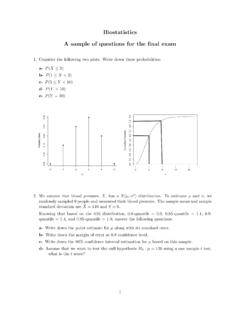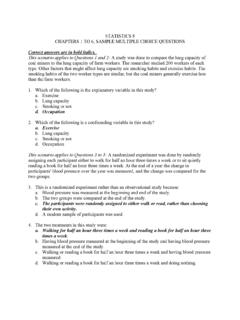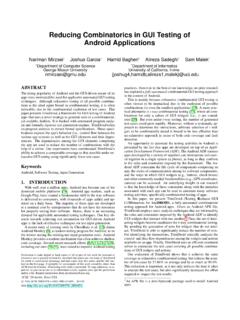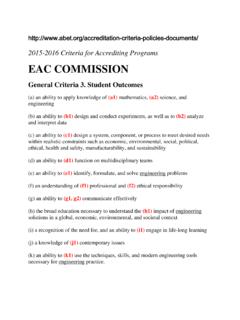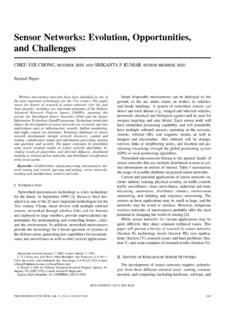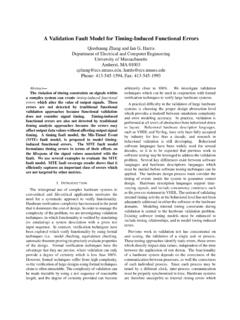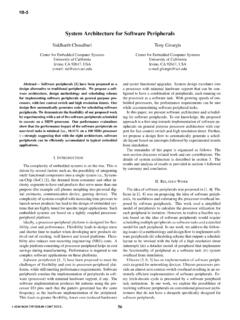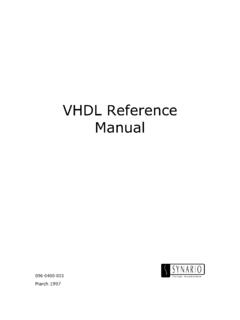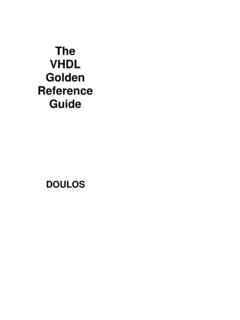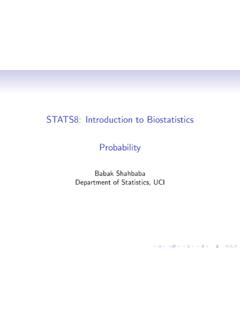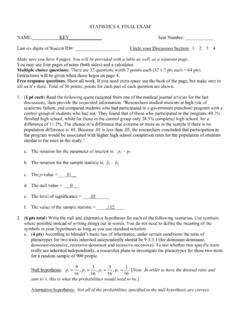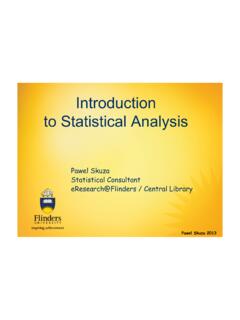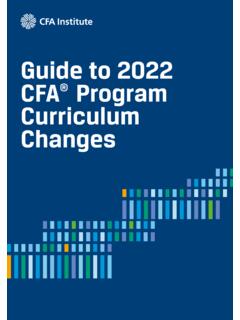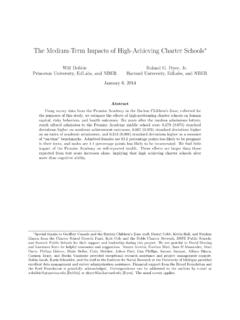Transcription of Sample Multiple Choice Questions for the material since ...
1 Sample Multiple Choice Questions for the material since Midterm 2. Sample Questions from Midterms 1 and 2 are also representative of Questions that may appear on the final exam. 1. A randomly selected Sample of 1,000 college students was asked whether they had ever used the drug Ecstasy. Sixteen percent (16% or ) of the 1,000 students surveyed said they had. Which one of the following statements about the number is correct? A. It is a Sample proportion. B. It is a population proportion. C. It is a margin of error. D. It is a randomly chosen number. 2. In a random Sample of 1000 students, p = (or 80%) were in favor of longer hours at the school library. The standard error of p (the Sample proportion) is A..013 B..160 C..640 D..800 3.
2 For a random Sample of 9 women, the average resting pulse rate is x= 76 beats per minute, and the Sample standard deviation is s = 5. The standard error of the Sample mean is A. B. C. D. 4. Assume the cholesterol levels in a certain population have mean = 200 and standard deviation = 24. The cholesterol levels for a random Sample of n = 9 individuals are measured and the Sample meanxis determined. What is the z-score for a Sample mean x= 180? A. B. C. D. 5. In a past General Social Survey, a random Sample of men and women answered the question Are you a member of any sports clubs? Based on the Sample data, 95% confidence intervals for the population proportion who would answer yes are .13 to .19 for women and .247 to.
3 33 for men. Based on these results, you can reasonably conclude that A. At least 25% of American men and American women belong to sports clubs. B. At least 16% of American women belong to sports clubs. C. There is a difference between the proportions of American men and American women who belong to sports clubs. D. There is no conclusive evidence of a gender difference in the proportion belonging to sports clubs. 6. Suppose a 95% confidence interval for the proportion of Americans who exercise regularly is to Which one of the following statements is FALSE? A. It is reasonable to say that more than 25% of Americans exercise regularly. B. It is reasonable to say that more than 40% of Americans exercise regularly. C. The hypothesis that 33% of Americans exercise regularly cannot be rejected.
4 D. It is reasonable to say that fewer than 40% of Americans exercise regularly. 7. In hypothesis testing , a Type 2 error occurs when A. The null hypothesis is not rejected when the null hypothesis is true. B. The null hypothesis is rejected when the null hypothesis is true. C. The null hypothesis is not rejected when the alternative hypothesis is true. D. The null hypothesis is rejected when the alternative hypothesis is true. 8. Null and alternative hypotheses are statements about: A. population parameters. B. Sample parameters. C. Sample statistics. D. it depends - sometimes population parameters and sometimes Sample statistics. 9. A hypothesis test is done in which the alternative hypothesis is that more than 10% of a population is left-handed.
5 The p-value for the test is calculated to be Which statement is correct? A. We can conclude that more than 10% of the population is left-handed. B. We can conclude that more than 25% of the population is left-handed. C. We can conclude that exactly 25% of the population is left-handed. D. We cannot conclude that more than 10% of the population is left-handed. 10. Which of the following is NOT true about the standard error of a statistic? A. The standard error measures, roughly, the average difference between the statistic and the population parameter. B. The standard error is the estimated standard deviation of the sampling distribution for the statistic. C. The standard error can never be a negative number. D. The standard error increases as the Sample size(s) increases.
6 11. A prospective observational study on the relationship between sleep deprivation and heart disease was done by Ayas, et. al. (Arch Intern Med 2003). Women who slept at most 5 hours a night were compared to women who slept for 8 hours a night (reference group). After adjusting for potential confounding variables like smoking, a 95% confidence interval for the relative risk of heart disease was ( , ). Based on this confidence interval, a consistent conclusion would be A. Sleep deprivation is associated with a modestly increased risk of heart disease. B. Sleep deprivation is associated with a modestly decreased risk of heart disease. C. There was no evidence of an association between sleep deprivation and heart disease. D. Lack of sleep causes the risk of heart disease to increase by 10% to 92%.
7 12. Consider a random Sample of 100 females and 100 males. Suppose 15 of the females are left-handed and 12 of the males are left-handed. What is the estimated difference between population proportions of females and males who are left-handed (females males)? Select the Choice with the correct notation and numerical value. A. p1 p2 = 3 B. p1 p2 = C. 21 pp = 3 D. 21 pp = 13. A result is called statistically significant whenever A. The null hypothesis is true. B. The alternative hypothesis is true. C. The p-value is less or equal to the significance level. D. The p-value is larger than the significance level. 14. The confidence level for a confidence interval for a mean is A. the probability the procedure provides an interval that covers the Sample mean.
8 B. the probability of making a Type 1 error if the interval is used to test a null hypothesis about the population mean. C. the probability that individuals in the population have values that fall into the interval. D. the probability the procedure provides an interval that covers the population mean. For the next two Questions : It is known that for right-handed people, the dominant (right) hand tends to be stronger. For left-handed people who live in a world designed for right-handed people, the same may not be true. To test this, muscle strength was measured on the right and left hands of a random Sample of 15 left-handed men and the difference (left - right) was found. The alternative hypothesis is one-sided (left hand stronger). The resulting t-statistic was 15.
9 This is an example of: A. A two- Sample t-test. B. A paired t-test. C. A pooled t-test. D. An unpooled t-test. 16. Assuming the conditions are met, based on the t-statistic of the appropriate conclusion for this test using = .05 is: (Table would be provided with exam.) A. Df = 14, so p-value < .05 and the null hypothesis can be rejected. B. Df = 14, so p-value > .05 and the null hypothesis cannot be rejected. C. Df = 28, so p-value < .05 and the null hypothesis can be rejected. D. Df = 28, so p-value > .05 and the null hypothesis cannot be rejected. 17. A test of H0: = 0 versus Ha: > 0 is conducted on the same population independently by two different researchers. They both use the same Sample size and the same value of = Which of the following will be the same for both researchers?
10 A. The p-value of the test. B. The power of the test if the true = 6. C. The value of the test statistic. D. The decision about whether or not to reject the null hypothesis . 18. Which of the following is not a correct way to state a null hypothesis ? A. H0: 0 21= pp ( Sample statistics do not go into hypotheses) B. H0: d = 10 C. H0: 1 2 = 0 D. H0: p = .5 19. A test to screen for a serious but curable disease is similar to hypothesis testing , with a null hypothesis of no disease, and an alternative hypothesis of disease. If the null hypothesis is rejected treatment will be given. Otherwise, it will not. Assuming the treatment does not have serious side effects, in this scenario it is better to increase the probability of: A. making a Type 1 error, providing treatment when it is not needed.
